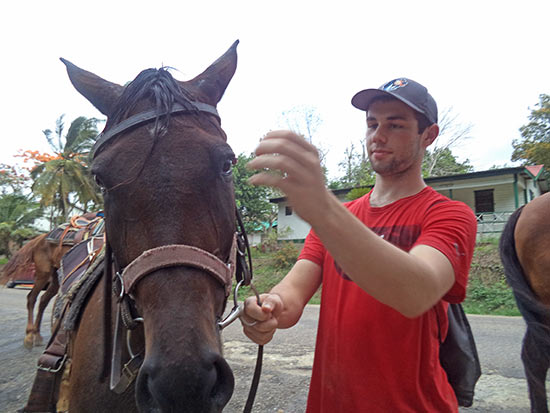Andrew Turner: Student Report from 2015 Alternative Summer Break in Belize

The volunteer engineering trip to Belize was one of the most rewarding experiences of my life. It was both a vacation and a time of relaxation as well as a time to help those who needed it and to become immersed in a culture in a way that is unlike any vacation. There were times to take breaks from work and explore the town and do a few touristy things but for the most part, we were there to work. That maybe does not sound like an ideal trip. Who wants to pay money to work for someone for free? You see, that is not the point of the trip. The trip is to use the resources and knowledge we have acquired and share it with those who desperately need it.
Working with our hosts, was this English woman named Julie. She told us that she had been working for many years and decided it was time to give back. Julie decided to take a year off and go country to country every six to eight weeks helping with whatever she could. This took me by surprise. How many times do you hear of someone quitting their job and taking a year off, simply to help people? This made me take a step back and realize maybe everything is not for personal gain or to spoil our loved ones. With so many people in the world living in poverty, it is the duty of those of us who are able to help, to indeed help. This trip helped bring these realizations to light.
With the personal impacts aside, the engineering aspect of the trip were very impressive. The goal of the trip was to help build dome houses using earth bag technology for orphaned girls who grew out of the orphan system. The people who hosted us, Nancy and Jaime, had a dream to help the growing orphan problem in Belize. They acquired a piece of land and devoted it to a sanctuary of sorts to orphaned children. One of the main goals is to make Barzakh Falah, the sanctuary, a totally self-sustainable environment. Jaime, our host, planned out everything in Barzakh Falah from the structural support of the buildings to the nutritional and medicinal effects of the plants and trees. The amount of thought that went into the planning of the site was incredible.
Earth bags are essentially heavy duty bags filled with dirt and a concrete substitute such as lime. The bags are stacked together and are basically used as bricks. When the framework using the bags is completed, it is lined with chicken wire and plastered together. The building turns out to be very strong and resilient yet maintains a cool interior without having power. The reason why the dome structure was chosen is due to the strength of the shape of a circle as a foundation and the walls act as a ceiling. The foundation is set on tires packed with dirt and rocks as a mechanical stabilizer in case of any shift in the earth. To maintain a perfect circle, a pole was set in the middle and a pole was attached perpendicularly to the center pole at a set length, this was called the “compass.”
The first task was to lay down the tires at the correct length. Two rows were put in place and then packed with dirt to create the mechanical stabilizers for the bags. Next came the bags. The process to fill the bags took about one hour, five steps, and filled roughly six bags. One team lowered dirt into the hole using a makeshift slide. The next team measures twenty buckets of dirt out and moves it to a mixing area. The twenty buckets is important because that is the proportion of dirt to lime that is needed. Water is then lowered into the hole using buckets tied to ropes. The dirt and lime is mixed with the water and then poured into the bags one by one. Once the bags are all in place, they are packed together to make a tight brick shape pattern. All the bags are then checked with the compass in order to maintain the proper radius and shape of the circle. The work was very difficult but it was very rewarding knowing that it was all to give someone a home.
After each work day, most of the group went into the town for some food and drinks and to visit the local shops. This proved to be a fantastic way to get to know the group and people I was working with as well as relax and do some touristy things. So the trip had a lot of difficult manual labor involved, but it also had many relaxing parts and some vacation type activities. Some of those activities involved canoeing down a local river, going to the countries zoo, and seeing a Mayan temple via horseback. The trip as a whole opened my eyes to problems outside my little world in Knoxville while immersing me in the Belizean culture. It let me help people who are doing a wonderful thing and also enjoying the country and its scenery. The trip was definitely a once in a lifetime experience and I recommend that everyone take a trip like it at least once in their life.